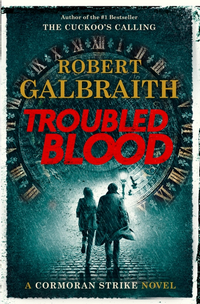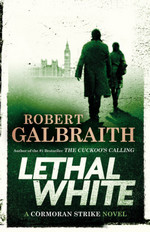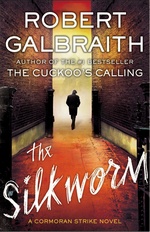 Troubled Blood
Troubled Blood
DETAILS: Series: Cormoran Strike, #5 Publisher: Mulholland Books Publication Date: September 14, 2020 Format: Hardcover Length: 927 pg. Read Date: February 23-March 2, 2022

I’ve jumped on each book in this series, but this book sat on my shelf for 16 months after its release. Now that I’ve finally tackled it, I’m afraid that it’ll take me 16 months to write this up the way I normally would.
So, I’m just going to offer some brief thoughts about the book. But first, let’s start with:
The Offical Description
Private Detective Cormoran Strike is visiting his family in Cornwall when he is approached by a woman asking for help finding her mother, Margot Bamborough – who went missing in mysterious circumstances in 1974.
Strike has never tackled a cold case before, let alone one forty years old. But despite the slim chance of success, he is intrigued and takes it on; adding to the long list of cases that he and his partner in the agency, Robin Ellacott, are currently working on. And Robin herself is also juggling a messy divorce and unwanted male attention, as well as battling her own feelings about Strike.
As Strike and Robin investigate Margot’s disappearance, they come up against a fiendishly complex case with leads that include tarot cards, a psychopathic serial killer and witnesses who cannot all be trusted. And they learn that even cases decades old can prove to be deadly . . .
Things I’m Not Going to Develop into Paragraphs:
 The Acknowledgments start with, “My thanks, as ever, to my superb editor David Shelley…” Why? What did Shelley do? I cannot be expected to believe that anything was cut, trimmed, or compressed. 900 pages is too long for a P.I. novel.
The Acknowledgments start with, “My thanks, as ever, to my superb editor David Shelley…” Why? What did Shelley do? I cannot be expected to believe that anything was cut, trimmed, or compressed. 900 pages is too long for a P.I. novel.
There’s very little that I can think of that Shelley or Galbraith should’ve cut, but that’s not my job, I’m just the reader. Those two get paid to eliminate the wasteful portions of this book.
 Two things that I think could’ve been slimmed down, if not eliminated were: the cases non-Bamborough cases that Strike, Robin, and their contractors were on. We could’ve just used passing references to them, we didn’t need all the space devoted to them.
Two things that I think could’ve been slimmed down, if not eliminated were: the cases non-Bamborough cases that Strike, Robin, and their contractors were on. We could’ve just used passing references to them, we didn’t need all the space devoted to them.
 There’s a storyline involving Robin and a contractor that took too long, and I get why Galbraith included it…but I have to keep arguing myself into accepting it.
There’s a storyline involving Robin and a contractor that took too long, and I get why Galbraith included it…but I have to keep arguing myself into accepting it.
 A lot has been made of the way that the serial killer suspected of Bamborough’s killing sometimes disguised himself as a woman. Given the public stances that Galbraith’s alter-ego has taken lately, this aspect of the character has come under fire. Which is understandable, and likely justified.
A lot has been made of the way that the serial killer suspected of Bamborough’s killing sometimes disguised himself as a woman. Given the public stances that Galbraith’s alter-ego has taken lately, this aspect of the character has come under fire. Which is understandable, and likely justified.
However, had Rowling not been embroiled in this controversy, or had anyone else written this character, I don’t think this character’s practice would’ve been controversial—it really comes across as his way of muddling witnesses and gaining the trust of a victim.
But she is the one who wrote this, and she is the one out there making those statements, and it’s hard to believe there’s no connection.
 I learned about a new philia while reading this book, and I really wish I hadn’t. It’s part of one of Strike and Robin’s other cases. I hope I don’t come across another reference to this in fiction or reality anytime soon so I’ll forget about it.
I learned about a new philia while reading this book, and I really wish I hadn’t. It’s part of one of Strike and Robin’s other cases. I hope I don’t come across another reference to this in fiction or reality anytime soon so I’ll forget about it.
 Troubled Blood contains the only Matthew storyline that I liked in this series And it took until the end of it (or maybe Robin’s thoughts about it after the end of it) for me to reach that conclusion. He’s really one of the worst characters I’ve endured in the last decade.
Troubled Blood contains the only Matthew storyline that I liked in this series And it took until the end of it (or maybe Robin’s thoughts about it after the end of it) for me to reach that conclusion. He’s really one of the worst characters I’ve endured in the last decade.
 Similarly, we got another Charlotte Campbell story. I could barely put up with that story. I did like Strike’s actions at the end of it (I’m only now seeing the parallel, which makes me realize that I hadn’t organized my thoughts too well before this), but I wish Strike had gotten there a book or two ago. Or that Galbraith had used less space for it here.
Similarly, we got another Charlotte Campbell story. I could barely put up with that story. I did like Strike’s actions at the end of it (I’m only now seeing the parallel, which makes me realize that I hadn’t organized my thoughts too well before this), but I wish Strike had gotten there a book or two ago. Or that Galbraith had used less space for it here.
 On the other hand, the story about Strike’s family (not his father and half-siblings, the family he was raised with) was fantastic.
On the other hand, the story about Strike’s family (not his father and half-siblings, the family he was raised with) was fantastic.
 Outside of a few scenes in each previous novel, this was the best display and development of the friendship between Robin and Strike. It’s also the most extended, which helps (this is actually not a reference to the length of the book).
Outside of a few scenes in each previous novel, this was the best display and development of the friendship between Robin and Strike. It’s also the most extended, which helps (this is actually not a reference to the length of the book).
 The Bamborough mystery was just great. The strengths and weaknesses it showed in both Strike and Robin were worth the effort getting through it all. Seeing them make mistakes and recovering from them—and seeing them make breakthroughs—this is the kind of thing that attracted me to the series in the first place, they’re both works-in-progress and it’s great to see them grow as investigators.
The Bamborough mystery was just great. The strengths and weaknesses it showed in both Strike and Robin were worth the effort getting through it all. Seeing them make mistakes and recovering from them—and seeing them make breakthroughs—this is the kind of thing that attracted me to the series in the first place, they’re both works-in-progress and it’s great to see them grow as investigators.
You cut out everything else in the book and just give us this? I’m raving about it. Period.
 Yeah, yeah, yeah, I know…you need subplots, character growth, etc. But really…
Yeah, yeah, yeah, I know…you need subplots, character growth, etc. But really…
 Did I mention this was too long?
Did I mention this was too long?
 This ultimately worked for me. But there are so many qualifications, disclaimers, bet-hedging, allowances, and so on to that evaluation, I’m not sure it’s worth much. Die-hard fans of the series will find reasons to like this. I don’t think this would bring on new fans—it’s definitely not a place for people to jump on to this series.
This ultimately worked for me. But there are so many qualifications, disclaimers, bet-hedging, allowances, and so on to that evaluation, I’m not sure it’s worth much. Die-hard fans of the series will find reasons to like this. I don’t think this would bring on new fans—it’s definitely not a place for people to jump on to this series.
 I said it last time, I’ll say it again, I hope the next book is leaner. But I doubt it will be.
I said it last time, I’ll say it again, I hope the next book is leaner. But I doubt it will be.

This post contains an affiliate link. If you purchase from it, I will get a small commission at no additional cost to you. As always, opinions are my own.
![]()







